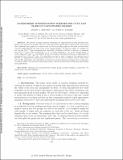Randomized Approximation Schemes for Cuts and Flows in Capacitated Graphs
Author(s)
Karger, David R.; Benczur, Andras A.
DownloadBenczur-2015-Randomized approximation.pdf (363.5Kb)
PUBLISHER_POLICY
Publisher Policy
Article is made available in accordance with the publisher's policy and may be subject to US copyright law. Please refer to the publisher's site for terms of use.
Terms of use
Metadata
Show full item recordAbstract
We describe random sampling techniques for approximately solving problems that involve cuts and flows in graphs. We give a near-linear-time randomized combinatorial construction that transforms any graph on n vertices into an O(n log n)-edge graph on the same vertices whose cuts have approximately the same value as the original graph's. In this new graph, for example, we can run the [~ over O](m[superscript 3/2])-time maximum flow algorithm of Goldberg and Rao to find an s-t minimum cut in [~ over O](m[superscript 3/2]) time. This corresponds to a (1 + ε)-times minimum s-t cut in the original graph. A related approach leads to a randomized divide-and-conquer algorithm producing an approximately maximum flow in [~ over O](m√n) time. Our algorithm can also be used to improve the running time of sparsest cut approximation algorithms from [~ over O](mn) to [~ over O](n[superscript 2]) and to accelerate several other recent cut and flow algorithms. Our algorithms are based on a general theorem analyzing the concentration of random graphs' cut values near their expectations. Our work draws only on elementary probability and graph theory.
Date issued
2015-03Department
Massachusetts Institute of Technology. Computer Science and Artificial Intelligence Laboratory; Massachusetts Institute of Technology. Department of Electrical Engineering and Computer ScienceJournal
SIAM Journal on Computing
Publisher
Society for Industrial and Applied Mathematics
Citation
Benczur, Andras A., and David R. Karger. “Randomized Approximation Schemes for Cuts and Flows in Capacitated Graphs.” SIAM Journal on Computing 44, no. 2 (January 2015): 290–319. © 2015 Society for Industrial and Applied Mathematics
Version: Final published version
ISSN
0097-5397
1095-7111